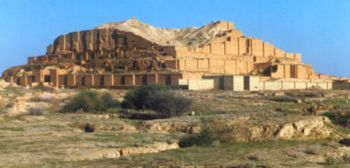
Ziggurats were pyramidal style structures built in Mesopotamia from about 2200 BC to about 500 BC. They were built of mud brick in its interior and covered by baked bricks and consisted of several levels, each level stepped back from the previous one. Most ziggurats were square and typically of about 40 - 50 m in side length. There were no internal chambers; access to the temple on the top was by exterior stairways or ramps.
The ziggurat Dur-Untash, or Choqa zanbil, was built near Susa around 1300 BC and is one of the world's best preserved ziggurats.

Susa, today's Shush in the Khuzistan region of Iran, was established as a human settlement at about 4500 BC. It became the capital of Sumer and Elam when Elam took over the administration of Sumer in about 2530 BC and had the largest of all ziggurats.
Photo: GNU Free Documentation License (Wikipedia)